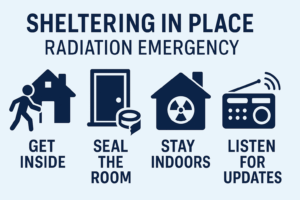Radiation is energy released from atoms in the form of waves or particles. While some exposure is natural and harmless, certain types (especially in emergencies like nuclear accidents or radiological attacks) can pose serious health risks.
Ionizing radiation (like gamma rays, x-rays, and particle radiation) can break DNA strands inside cells Cells may repair themselves successfully, die off (causing tissue damage or organ failure), or mutate and reproduce abnormally, increasing cancer risk.
Radiation affects rapidly dividing cells most. Bone marrow, where immune cells are produced, is especially vulnerable. Exposure may in weakened immunity, increased risk of infection, and impaired wound healing.
Knowing the different types of radiation can help you better understand what protective actions to take.
How Exposure Happens:
Examples: Plutonium-239, Americium-241 in smoke detectors, radon gas.
How Exposure Happens:
Examples: Strontium-90, Carbon-14, radioactive medical tracers.
How Exposure Happens:
Examples: Cesium-137, cobalt-60, fallout from nuclear weapons or reactor accidents.
How Exposure Happens:
Examples: Medical X-ray machines, airport scanners, industrial inspection equipment.
How Exposure Happens:
Examples: Nuclear weapons testing, research reactors.
Most people don’t plan to be in the middle of a protest, riot, or volatile public event—but it can happen unexpectedly. You might be commuting, attending a large gathering, or just in the wrong place at the wrong time.

If a nuclear bomb has been detonated or a reactor has exploded, you will not have time to escape the fallout zone. Fallout can begin settling within 10–20 minutes of the explosion and can travel for miles, carried by wind. In this critical window, your best chance of survival is to shelter in place immediately.